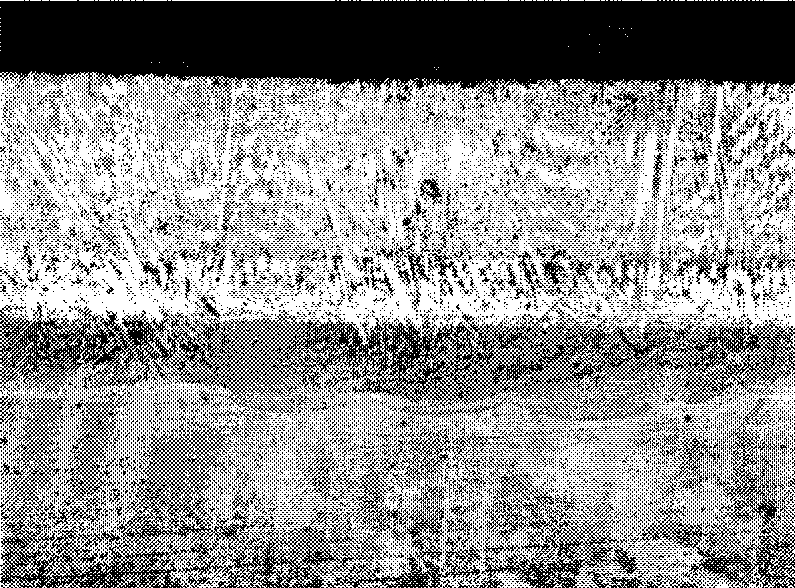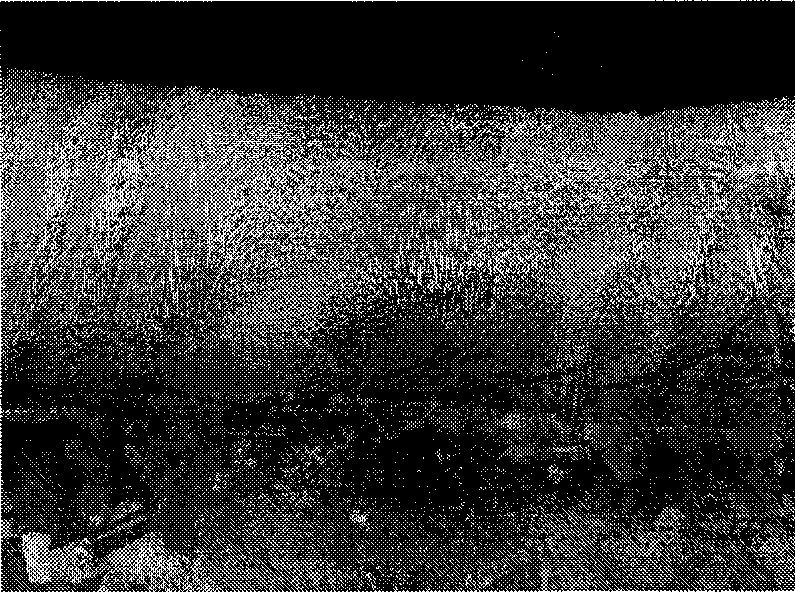Copper-base crystallizer surface laser cladding method
A technology of laser cladding and crystallizer, which is applied in the directions of fusion sputtering, superimposed layer plating, coating, etc., can solve problems such as affecting the bonding of copper matrix and cladding layer, oxidation of copper base material, poor melting, etc.
- Summary
- Abstract
- Description
- Claims
- Application Information
AI Technical Summary
Problems solved by technology
Method used
Image
Examples
Embodiment 1
[0027] ①Wipe the copper plate of the crystallizer with acetone to degrease, degrease with TGY-1 electrocleaning solution and activate with THY-2 activation solution, and then brush TDY-102 pure nickel coating with a voltage of 10V. The thickness of each brush plating is 0.05mm, and the thickness of the transition layer after 6 brush platings is 0.30mm;
[0028] ②Adjust CO 2 The power of the laser beam is 4000W, the laser beam is gathered into a spot of 3mm, the scanning speed of the control beam is 1000mm / min, and the transition layer is overlapped and scanned, and the overlap rate is 10%. During the scanning process, the back of the copper plate of the crystallizer is cooled by forced water , control the surface temperature below 300°C;
[0029] ③The transition layer is sandblasted and roughened, supersonic flame spraying is carried out, and the nickel-based alloy is sprayed. The Ni content in the nickel-based alloy is 96%, the C content is 0.1%, the total content of Cr, Si,...
Embodiment 2
[0033] ① After degreasing the copper plate of the crystallizer with acetone, roughen it by sand blasting, and control the roughness at Ra2~4μm, and carry out supersonic flame spraying. The spraying material is nickel-based alloy powder, and the composition: C content 0.05%, Cr, Si, B The total content is 3.5%, the Ni content is 96.45%, the particle size range is +5~-25μm, and the spraying thickness is 0.4mm;
[0034] ②Adjust CO 2 The laser beam power is 8000W, the laser beam is gathered into a 5mm spot, the beam scanning speed is 2000mm / min, and the overlap rate is 30%. During the scanning process, the back of the copper plate of the crystallizer is cooled by forced water to control the surface temperature of the workpiece below 300°C;
[0035] ③ Repeat step ① to carry out supersonic spraying of nickel-based alloy powder, the particle size range is +5 ~ -25μm, the content of Ni in the nickel-based powder alloy is 96%, the content of C is 0.1%, the total content of Cr, Si and B...
Embodiment 3
[0039]①Wipe the copper plate of the crystallizer with acetone to remove oil, and put it into the plating tank of nickel salt solution. The nickel salt solution is 100g / L of nickel sulfate, 21g / L of magnesium sulfate, 14g / L of boric acid, and 4g / L of sodium chloride. Voltage 8V, current density 2A / dm 2 , the transition layer thickness is 0.50mm;
[0040] ②Adjust CO 2 The power of the laser beam is 10000W, the laser beam is gathered into a spot of 6mm, the scanning speed of the laser beam is 3000mm / min, and the overlapping rate is controlled at 50%. 300°C;
[0041] ③ After degreasing the welded transition layer with acetone, sandblasting and roughening, the roughness is controlled at Ra2-4μm, and supersonic flame spraying is carried out. The spraying material is cobalt-based alloy powder, and the composition of cobalt-based alloy is: C content 0.1%, the total content of Cr, Si, B, W is 5%, the content of Fe is 1%, the balance of cobalt; the particle size range is +5~-25μm, an...
PUM
| Property | Measurement | Unit |
|---|---|---|
| thickness | aaaaa | aaaaa |
| thickness | aaaaa | aaaaa |
Abstract
Description
Claims
Application Information
 Login to View More
Login to View More - R&D
- Intellectual Property
- Life Sciences
- Materials
- Tech Scout
- Unparalleled Data Quality
- Higher Quality Content
- 60% Fewer Hallucinations
Browse by: Latest US Patents, China's latest patents, Technical Efficacy Thesaurus, Application Domain, Technology Topic, Popular Technical Reports.
© 2025 PatSnap. All rights reserved.Legal|Privacy policy|Modern Slavery Act Transparency Statement|Sitemap|About US| Contact US: help@patsnap.com



